| Jutland:
The Battle, Part Three:
Torpedo Run
By Mike Bennighof, Ph.D.
May 2024
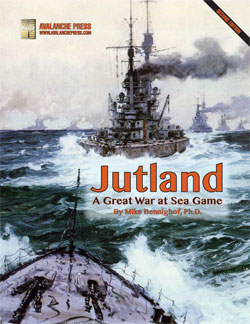 While the battle cruisers fought it out in the first hour (almost exactly) of the Battle of Jutland, the light cruisers, destroyers, and torpedo boats fought a savage brawl of their own. Counting the escorts brought along by 5th Battle Squadron, the British Battle Cruiser Fleet had fifteen light cruisers and 26 destroyers. The German Second Scouting Group escorting Hipper’s battle cruisers numbered five light cruisers and thirty torpedo boats. While the battle cruisers fought it out in the first hour (almost exactly) of the Battle of Jutland, the light cruisers, destroyers, and torpedo boats fought a savage brawl of their own. Counting the escorts brought along by 5th Battle Squadron, the British Battle Cruiser Fleet had fifteen light cruisers and 26 destroyers. The German Second Scouting Group escorting Hipper’s battle cruisers numbered five light cruisers and thirty torpedo boats.
Once battle had been joined, the smaller ships had two, related tasks: to conduct torpedo attacks against enemy capital ships and to prevent the enemy’s light forces from doing the same to their own. At 1709, Beatty signaled his flotillas, by way of Princess Royal, “Attack the enemy with torpedoes.” But the “Run to the South” had put the light forces of both sides out of position, as they needed to attack from ahead of the enemy line, or their targets would have too long to shoot at them as the small vessels labored to catch them. On both sides, the light ships pressed southward to get back to the front of their respective columns.
On the British side, ten destroyers on the battle cruisers’ disengaged (starboard) side, most of them from the 13th Flotilla, sought to overtake the British flagship Lion and assume an attack position. Six destroyers of the 9th Flotilla had been steaming on the engaged (port) side, pouring their coal smoke across the gunnery directors of Lion, Princess Royal and Tiger. At 1710 Lion had ordered them to clear the range and four of them dropped back as ordered. The other two pressed forward even harder, pumping out still more smoke but managing to join 13th Flotilla’s destroyers in front of Lion.
Confusion followed the attack order; not all destroyers could keep up, and the 13th Flotilla’s flagship, the light cruiser Champion, failed to join them. Believing that the destroyers needed support from heavier guns, Commodore William Goodenough of the 2nd Light Cruiser Squadron ordered the light cruiser Nottingham to join the destroyers, but the cruiser only succeeded in scattering the destroyers further when she passed through their formation.
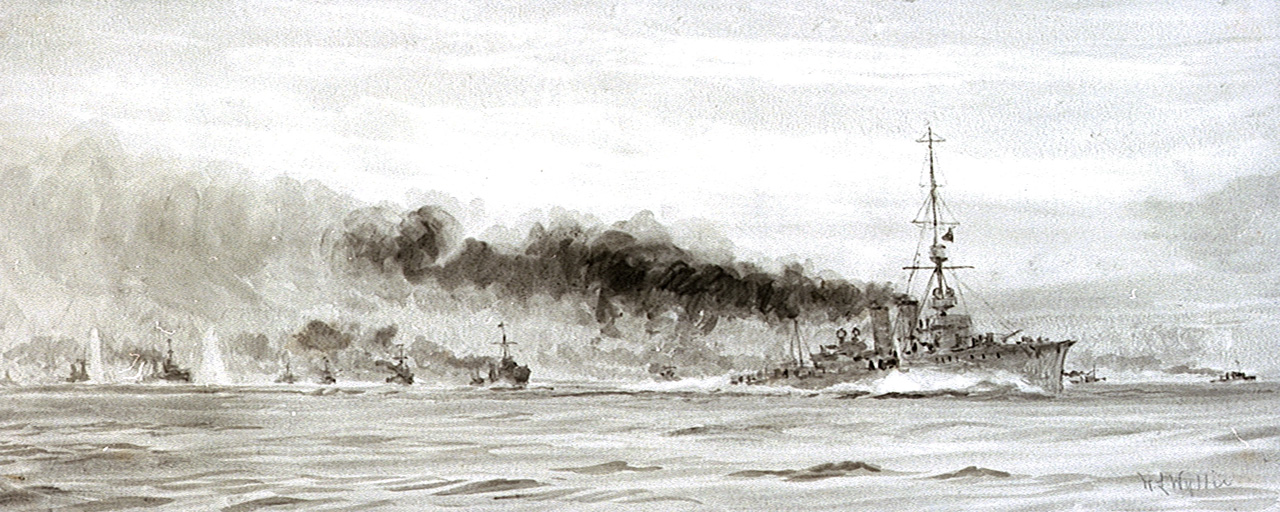
HMS Champion leads the 13th Destroyer Flotilla. She failed to do so during the battle.
By that point, the German light ships had also reached the front of their own line. Second Scouting Group’s flagship, the light cruiser Regensburg, hoisted the red Z signal directing the German torpedo boats to attack. The German boats came on in piecemeal fashion, as they reached a position where they could safely cut across the bows of the lead German battle cruiser Lützow. At 1720 both sides opened fire; it’s not clear who shot first but it was only a matter of seconds before a brutal, close-quarters fight raged between the British destroyers and German torpedo boats.
While the light ships fought, the heavy ships continued to fire at each other, and their shells roared over the destroyers and torpedo boats, creating a nightmare environment of thick smoke from both gunfire and coal-fired boilers, ear-splitting sounds, explosions, and shell splashes. The battle cruisers joined in with their secondary armament, the lighter weapons intended to repel torpedo attacks.
Only two British destroyers, Nestor and Nicator, got within 6,000 yards of the German battle cruiser line. They loosed four torpedoes between them; one failed to run at all and the other three missed. Other British boats loosed their own torpedoes from beyond effective range; of the twenty-one torpedoes launched at the Germans (ten at the battle cruisers, ten at the approaching High Seas Fleet battleships, and one at a torpedo boat), one struck the battle cruiser Seydlitz, doing minimal damage, and another struck and sank the torpedo boat V29. For their part, the Germans failed to get closer than 8,000 yards from the British battle cruisers, and loosed twelve torpedoes, none of which found a target. The German torpedoes may not have even reached the British battle line; only Barham reported seeing one.
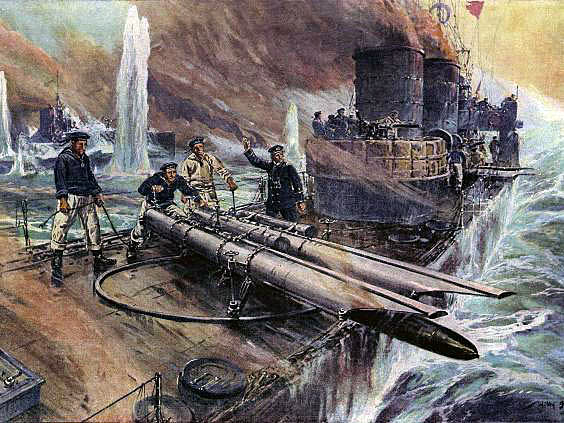
SMS V44 looses a torpedo during the Battle of Jutland.
While the battle of the light ships had little direct impact on the big ships’ fight, it did divert their attention and at 1736 Hipper turned his line to the east to avoid the British destroyers. Soon afterwards the British sighted the German battle fleet approaching, and at 1746 the British battle cruisers turned about to the west to join the oncoming dreadnoughts of the British Grand Fleet, approaching from the north-west.
The light forces followed the battle cruisers, except for the four ships of Goodenough’s 2nd Light Cruiser Squadron, which pressed on at 25 knots in an attempt to gain clearer information of approaching German strength. Nottingham launched a torpedo at over 15,000 yards, well beyond the effective range of the ship’s Mark IV torpedoes, to no effect.
Aboard the High Seas Fleet’s dreadnoughts, lookouts spotted the approaching furball at 1730. Scheer ordered an increase in speed and slight turn to bring the enemy closer. At 1745 the flagship Friedrich der Grosse ordered each ship to engage one enemy target, and at 1746 came to long-awaited signal “Open Fire.”
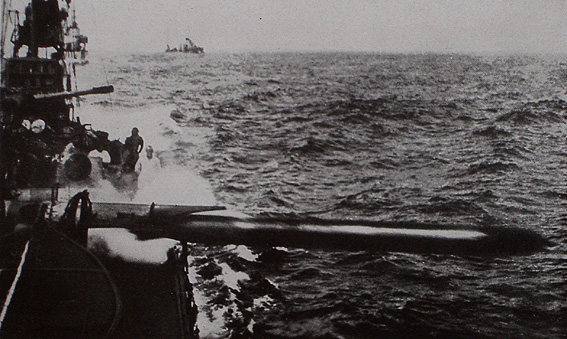
A German torpedo boat launches a torpedo during the Battle of Jutland.
That brought the first phase of the Battle of Jutland to a close. So far, the Germans had done extremely well: the heavy guns of their five battle cruisers had scored 44 hits against British capital ships, compared to just 17 for the ten British heavy ships (six battle cruisers and four battleships). Two British battle cruisers had exploded and two destroyers had been crippled (both of the latter would be sunk by the oncoming German battleships). One British battle cruiser (Lion) had been badly damaged; another (Tiger) had been hit by fourteen 280mm shells (13 of those from Moltke).
All of the German heavy ships remained in action. The flagship, Lützow, had already suffered the hit to her bow that would contribute to her eventual, slow sinking. Von der Tann had had most of her guns put out of action, while Seydlitz had lost a gun turret and Moltke had suffered some flooding. Derfflinger, the lucky Iron Dog, had been hit just once, by a 4-inch shell that shattered a skylight. Two German torpedo boats had been sunk.
Hipper had handled his smaller squadron far more effectively than Beatty; only one ship (Derfflinger) had her fire masked by smoke for any appreciable length of time. Beatty paid most of his attention to the ships of his First Battle Cruiser Squadron (the “Splendid Cats” - Lion, Princess Royal, Queen Mary and Tiger) and offering little direction to the two less-capable ships of Second Battle Cruiser (New Zealand and Indefatigable). Beatty almost ignored the four powerful “fast” battleships of Fifth Battle Squadron, leaving the squadron commander to exercise his own initiative more than once – not the done thing in the Royal Navy of 1916.
The next phase of the battle, the “Run to the North,” would be in the hands of fleet commanders Jellicoe and Scheer.
The story continues in Part Four.
Order Jutland second edition here.
The Jutland Experience
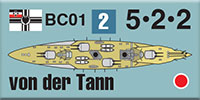 Jutland Second Edition (full game) Jutland Second Edition (full game)
Jutland: North Sea 1914
Jutland: Dogger Bank
Journal No. 46: Iron Dogs
Retail Price: $179.96
Package Price: $150.00
Gold Club Price: $120.00
You can order the Jutland Experience right here.
Sign up for our newsletter right here. Your info will never be sold or transferred; we'll just use it to update you on new games and new offers.
Mike Bennighof is president of Avalanche Press and holds a doctorate in history from Emory University. A Fulbright Scholar and NASA Journalist in Space finalist, he has published a great many books, games and articles on historical subjects; people are saying that some of them are actually good.
He lives in Birmingham, Alabama with his wife, three children, and his new puppy. His Iron Dog, Leopold, could swim very well.
Want to keep Daily Content free of third-party ads? You can send us some love (and cash) through this link right here.
|
